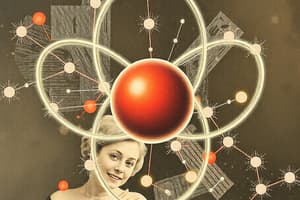Podcast
Questions and Answers
Which particle has a mass of approximately $1.673 imes 10^{-24}$ grams?
Which particle has a mass of approximately $1.673 imes 10^{-24}$ grams?
- Hydrogen atom
- Neutron
- Proton (correct)
- Electron
Which statement accurately describes neutrons?
Which statement accurately describes neutrons?
- Neutrons have a positive charge and are found outside the nucleus.
- Neutrons are responsible for the chemical properties of elements.
- Neutrons always equal the number of electrons in an atom.
- Neutrons do not contribute to the atomic number of an element. (correct)
What is the relative mass of an electron in atomic mass units (amu)?
What is the relative mass of an electron in atomic mass units (amu)?
- 1.0000 amu
- 1.673 x 10⁻²⁴ amu
- 1.0073 amu
- 0.0005486 amu (correct)
Which type of molecule consists of more than one element?
Which type of molecule consists of more than one element?
What defines the isotope of an atom?
What defines the isotope of an atom?
Which statement accurately describes isotopes?
Which statement accurately describes isotopes?
In the structure of an atom, what role do neutrons play?
In the structure of an atom, what role do neutrons play?
What did Ernest Rutherford discover regarding atomic structure?
What did Ernest Rutherford discover regarding atomic structure?
Which of the following statements about electrons is FALSE?
Which of the following statements about electrons is FALSE?
What did John Joseph Thomson contribute to atomic theory?
What did John Joseph Thomson contribute to atomic theory?
Flashcards are hidden until you start studying
Study Notes
Subatomic Particles
- Electrons (e-) are negatively charged, have a mass of approximately 9.109 x 10⁻²⁸ grams, and make up the electron cloud surrounding the nucleus.
- Protons (p+) carry a positive charge and have a mass of 1.673 x 10⁻²⁴ grams with a relative mass of 1.0073 amu; they define the atomic number of an element.
- Neutrons (n0) are neutral particles, discovered by James Chadwick, with a mass of about 1.0087 amu; they play a crucial role in the stability of the nucleus.
Atomic Structure
- Atoms consist of a dense nucleus containing protons and neutrons, surrounded by electrons in motion.
- The atomic theory, initiated by Democritus, emphasizes that all matter is composed of atoms.
- The Bohr model illustrates how electrons occupy defined energy levels around the nucleus.
Molecular Types
- Homonuclear molecules are formed from one kind of element (e.g., O₂).
- Heteronuclear molecules consist of multiple elements (e.g., H₂O).
Chemical Bonding
- Ionic bonds form between metals and nonmetals through electron transfer, resulting in positively charged cations and negatively charged anions.
- Covalent bonds involve sharing electron pairs between atoms; critical for the formation of molecules.
- Hydrogen bonds are weak non-covalent interactions significant in molecular interactions.
Isotopes
- Isotopes are variants of the same element that have different numbers of neutrons, affecting atomic stability.
Periodic Table Trends
- Elements are arranged by atomic number, leading to periodic trends in properties such as density, atomic radius, and ionization energy.
- Nonmetals typically gain electrons (forming anions), while metals tend to lose electrons (forming cations) based on their valence electron configuration.
Reactivity
- Non-metal reactivity increases as elements more easily gain electrons to achieve a stable electronic configuration.
- Metal reactivity is assessed by their ability to lose electrons; less energy is required for those with fewer valence electrons.
Ionization Energy and Electronegativity
- Ionization energy measures the energy required to remove the outermost electron from a gaseous atom, with non-metals exhibiting higher ionization energies.
- Electronegativity, measured in Pauling units, indicates an atom's ability to attract electrons in a bond, with fluorine being the most electronegative element.
Chemical Names and Formulas
- Ionic compounds consist of metal and non-metal ions, typically latticed with loose attachment.
- In naming binary ionic compounds, the cation is named first followed by the anion name, modified to end in "ide."
Allotropes
- Elements can exist in different structural forms (allotropes) even in the same phase, such as graphite and diamond, both of which are forms of carbon.
Studying That Suits You
Use AI to generate personalized quizzes and flashcards to suit your learning preferences.




